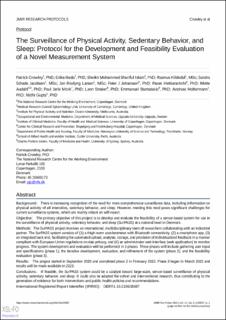The Surveillance of Physical Activity, Sedentary Behavior, and Sleep: Protocol for the Development and Feasibility Evaluation of a Novel Measurement System
| dc.contributor.author | Crowley, Patrick | |
| dc.contributor.author | Ikeda, Erika | |
| dc.contributor.author | Islam, Sheikh Mohammed Shariful | |
| dc.contributor.author | Kildedal, Rasmus | |
| dc.contributor.author | Jacobsen, Sandra Schade | |
| dc.contributor.author | Larsen, Jon Roslyng | |
| dc.contributor.author | Johansson, Peter J. | |
| dc.contributor.author | Hettiarachchi, Pasan | |
| dc.contributor.author | Aadahl, Mette | |
| dc.contributor.author | Mork, Paul Jarle | |
| dc.contributor.author | Straker, Leon | |
| dc.contributor.author | Stamatakis, Emmanuel | |
| dc.contributor.author | Holtermann, Andreas | |
| dc.contributor.author | Gupta, Nidhi | |
| dc.date.accessioned | 2023-03-03T08:55:15Z | |
| dc.date.available | 2023-03-03T08:55:15Z | |
| dc.date.created | 2022-09-16T08:56:50Z | |
| dc.date.issued | 2022 | |
| dc.identifier.citation | JMIR Research Protocols. 2022, 11 (6), . | en_US |
| dc.identifier.issn | 1929-0748 | |
| dc.identifier.uri | https://hdl.handle.net/11250/3055625 | |
| dc.description.abstract | Background: There is increasing recognition of the need for more comprehensive surveillance data, including information on physical activity of all intensities, sedentary behavior, and sleep. However, meeting this need poses significant challenges for current surveillance systems, which are mainly reliant on self-report. Objective: The primary objective of this project is to develop and evaluate the feasibility of a sensor-based system for use in the surveillance of physical activity, sedentary behavior, and sleep (SurPASS) at a national level in Denmark. Methods: The SurPASS project involves an international, multidisciplinary team of researchers collaborating with an industrial partner. The SurPASS system consists of (1) a thigh-worn accelerometer with Bluetooth connectivity, (2) a smartphone app, (3) an integrated back end, facilitating the automated upload, analysis, storage, and provision of individualized feedback in a manner compliant with European Union regulations on data privacy, and (4) an administrator web interface (web application) to monitor progress. The system development and evaluation will be performed in 3 phases. These phases will include gathering user input and specifications (phase 1), the iterative development, evaluation, and refinement of the system (phase 2), and the feasibility evaluation (phase 3). Results: The project started in September 2020 and completed phase 2 in February 2022. Phase 3 began in March 2022 and results will be made available in 2023. Conclusions: If feasible, the SurPASS system could be a catalyst toward large-scale, sensor-based surveillance of physical activity, sedentary behavior, and sleep. It could also be adapted for cohort and interventional research, thus contributing to the generation of evidence for both interventions and public health policies and recommendations. | en_US |
| dc.language.iso | eng | en_US |
| dc.publisher | JMIR Publications | en_US |
| dc.rights | Navngivelse 4.0 Internasjonal | * |
| dc.rights.uri | http://creativecommons.org/licenses/by/4.0/deed.no | * |
| dc.title | The Surveillance of Physical Activity, Sedentary Behavior, and Sleep: Protocol for the Development and Feasibility Evaluation of a Novel Measurement System | en_US |
| dc.title.alternative | The Surveillance of Physical Activity, Sedentary Behavior, and Sleep: Protocol for the Development and Feasibility Evaluation of a Novel Measurement System | en_US |
| dc.type | Peer reviewed | en_US |
| dc.type | Journal article | en_US |
| dc.description.version | publishedVersion | en_US |
| dc.source.pagenumber | 0 | en_US |
| dc.source.volume | 11 | en_US |
| dc.source.journal | JMIR Research Protocols | en_US |
| dc.source.issue | 6 | en_US |
| dc.identifier.doi | 10.2196/35697 | |
| dc.identifier.cristin | 2052292 | |
| cristin.ispublished | true | |
| cristin.fulltext | original | |
| cristin.qualitycode | 1 |

